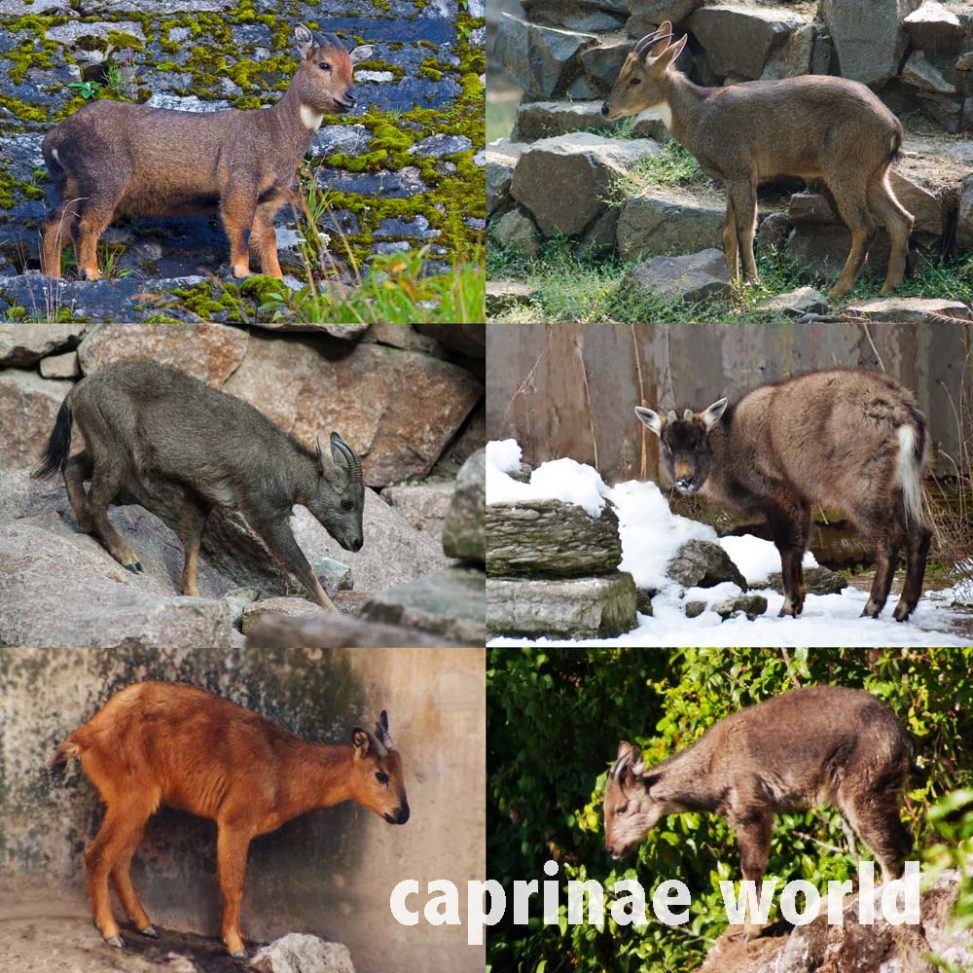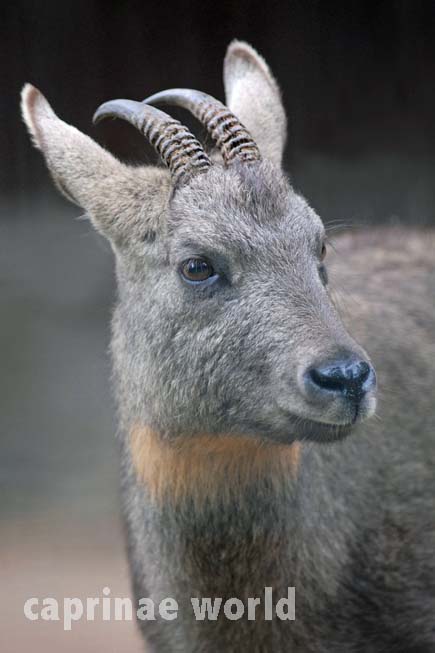Gorals are small caprinae species with a goat- or antelope-like appearance occurring in South Asia and Far East. The number of species is still not clear. Six possible species are listed in this chapter. Seven species are likely to occur. This chapter was last updated: 2024-04-08
Names
The vernacular name „goral“ stems from the Hindi language. The scientific name Nemorhaedus is derived from Latin nemoralis meaning „of woods, or groves“ and haedus „young goat“. [1]
The spelling of the name Nemorhaedus is controversial. In the original publication, 1827, Hamilton Smith uses Naemorhedus [3]. Many authors in recent years prefer Nemorhaedus [2, 3, 4] – probably because Nemorhaedus is the etymological correct version (see paragraph above).

Information board at the Himalayan Goral enclosure, National Zoological Park Delhi, India. Since taxonomists do not agree on the right spelling, you don’t have to wonder that institutions like zoos – who depend on the work of taxonomists – come up with their own versions. Photo: Ralf Bürglin
In respect of the two Himalayan Goral phenotypes Hrabina (2015) suggests a name change: Formerly the scientific name of the Western Himalayan Goral was Nemorhaedus bedfordi or Nemorhaedus goral bedfordi respectively, and the name for the Eastern Himalayan Goral was Nemorhaedus goral or Nemorhaedus goral goral respectively. According to Hrabina the name Nemorhaedus goral should be borne by the Western Himalayan Goral species, while the Eastern Himalayan species should be referred to as Nemorhaedus hodgsoni. The explanation for this step follows in the chapter for the Himalayan Gorals.
Taxonomy
Until 1985 only one species of goral was recognised. Then Groves and Grubb (1985) split it into three species: the Long-tailed Goral (Nemorhaedus caudatus) from Asia Far East), the Red Goral (Nemorhaedus bailey), from North Myanmar, North-East India and South China, and the Brown Goral (Nemorhaedus goral), all along the Himalayas, up to North-East Pakistan. [8]
Later on, Grubb (2005) split the Grey Goral (Nemorhaedus griseus) from East-Central China, Myanmar and Thailand, from Nemorhaedus caudatus (North China, Korean peninsula, East Russia), increasing the total number of goral species to four. [8]
Valdez (2011) recognised six goral species by separating the Himalayan Goral (Nemorhaedus bedfordi), Western Himalayas to North-East Pakistan, and the Burmese Goral (Nemorhaedus evansi) from Myanmar and Thailand, formerly subspecies of Nemorhaedus goral and Nemorhaedus griseus, respectively. [8]
Groves and Grubb (2011) recognised six goral species mainly based on morphological criteria. They identifiy Himalayan Brown Goral (Nemorhaedus goral), N. bedfordi (no common name given), Chinese Goral (Nemorhaedus griseus), Burmese Goral (N. evansi), Long-tailed Goral (N. caudatus), Red Goral (N. bailey). [3]
Hrabina (2015) presented detailed descriptions of pelage features of all the extant taxa and defines determination features, which help to identify individual specimens. The results of his study, based on the research of 979 field photographs of animals and 84 skins collected by museums around the world, confirm the existence of six species. [7] Hrabina’s work is particularly important because it is based primarily on morphology. Groves and Grubb (2011) wrote: „DNA data … might not send precisely the same message as morphology.“ [3]
Mori et al. (2019) have revised the taxonomy and phylogeny of gorals, using the mitochondrial genome of the taxa. They confirm the existence of three goral species. They couldn’t find a justification for the existence of Chinese Goral, Himalayan Goral and Burmese Goral on a species level and suggest to pool these three taxa, Nemorhaedus griseus, Nemorhaedus bedfordi and Nemorhaedus evansi, within one species: Brown Goral (Nemorhaedus goral). [8]
Li et al. (2022) compared all available whole mitogenomic sequences, including eight new ones from northern Myanmar. They recognise five distinct species. According to them Naemorhedus griseus is a synonym of Naemorhedus goral. They prove Naemorhedus evansi to be a valid species, with a geographic range that extends northwards into southwestern China. Naemorhedus cranbrooki and Naemorhedus baileyi are distinct species, not synonyms. [9]
Joshi et al. (2022) revisited goral taxonomy by sequencing mitochondrial Cytochrome b gene (∼404 bp) and control region (∼225 bp) of 75 Himalayan gorals from Western and Central Himalayas in India (but not from Northeast India / Arunachal Pradesh). Based on various species delineating methods, they suggest that Himalayan Goral (N. goral) is a highly diverged species and possibly exists into two subspecies, i.e. N. g. bedfordi in Western Himalayas and N. g. goral in the Central Himalayas. They validate the presence of plausibly six species of gorals across the distribution and recognise N. griseus and N. goral are two distinct species considering the observed discrepancy in the available sequences. [10]
Hrabina et al. (2023) examined the phylogenetic relationships and species delimitation in gorals using all currently available cytochrome oxidase subunit I sequences, including the not yet analysed goral population from Pakistan. Their results of various phylogenetic approaches, such as maximum parsimony, likelihood and Bayesian inference, and exploration of species boundaries via species delimitation support the validity of six species of goral, namely N. baileyi, N. caudatus, N. cranbrooki, N. evansi, N. goral, and N. griseus. [11]
Similar taxa
The genus that is closest to the gorals is Capricornis, the serows. Superficially seen, the two genera show similarities, but they differ consistently in some characteristics, particularly features of the scull and other morphological differences. And there is also behavioral and ecological distinctions. [1]
Distribution
Gorals are native to East Asia. Their distribution area extends from Pakistan, along the Himalayas to China, South and North Korea to the Far East of Russia as well as from Northeast India, via Myanmar to Thailand.
Description
Gorals are comparably small and lightweight. They weigh 20-47 kg. Shoulder hight is 50-75 cm. [4] The Red Goral (N. baileyi) is the smallest goral species [1], the Longtailed Goral (N. caudatus) the biggest. [4] Males and females are of similar size.
The pelage consists of a short, wooly undercoat covered with long, coarse outer hair. [1] Coloration differs between species. It ranges from light grey, grey-brown, dark red-brown to foxy red. There is a white, yellowish or pale orange throat patch. Some forms have a black dorsal stripe. Gorals have no beard.
The tails of the various species are of different length and colour. The tail length is in so far of importance, since it is eponymous, i.e. being the basis for the naming of two taxa. Damm and Franco (2014) indicate the Long-tailed Goral (Nemorhaedus caudatus) as having the longest tail of all goral species, 15 cm without hair! [1]. (With hair it was found to be 37-48 cm long.) [4]. Presumably because they found the Chinese Goral (Nemorhaedus griseus) to have a similar long tail (13 cm), they named it „Grey-Long-tailed Goral“ – which is confusing, because the two taxa are different species.
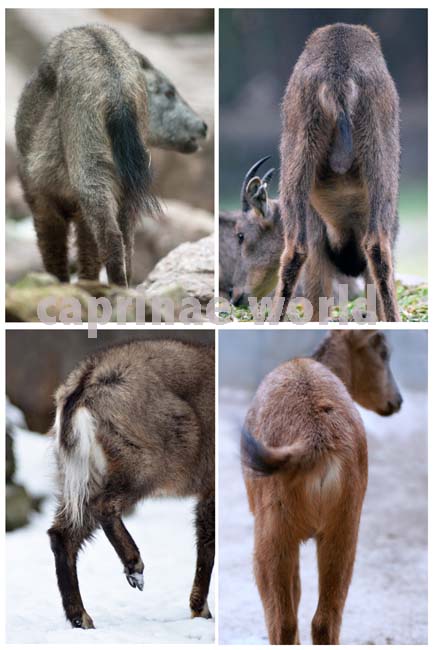
Posterior view of Chinese Goral (top left), Himalayan Grey Goral (top right), Armur long-tailed Goral (bottom left), Red Goral (bottom right). Note that the tail of the Himalayan Grey Goral (top right) is very short. What looks like the lower part of it is actually the scrotum. Photos: Ralf Bürglin
The very long white hairs that grow on the lateral surfaces of the tail in Long-tailed Goral are very conspicuous – in fact they constitute one of the most distinctive features for determining this species. [7]
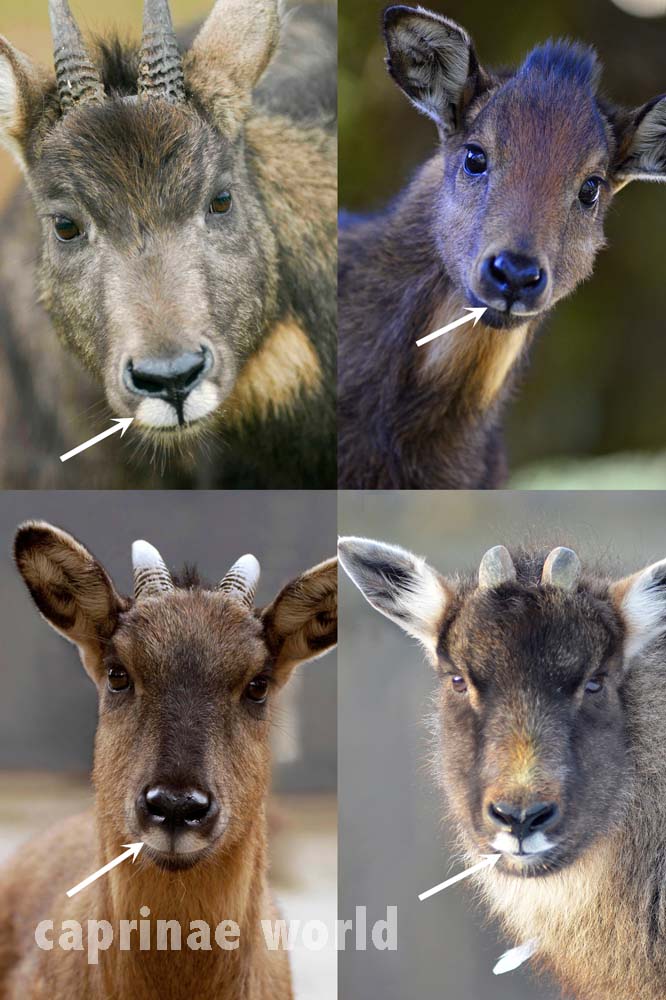
A very quaint peculiarity in gorals is a white double crescent on the upper lip. Chinese Goral (up left), Himalayan Brown Goral (up right), Red Goral (bottom left), Long-tailed Goral (bottom right). Photos: Ralf Bürglin
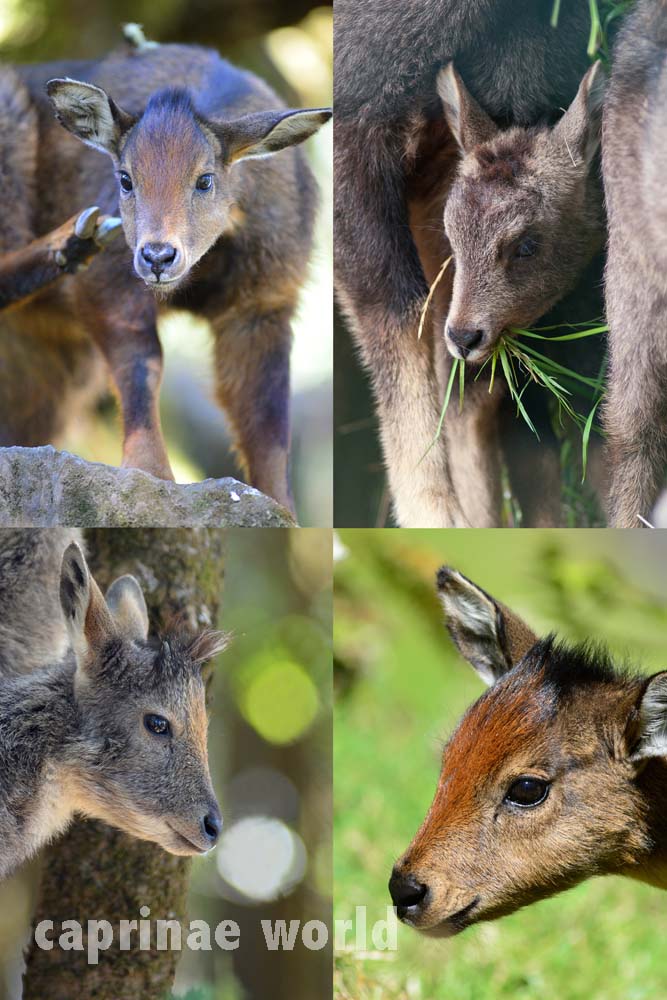
Another peculiarity in gorals is a tuft of dark hair that appears only in juveniles. Himalayan Brown Goral (up left), Chinese Goral (up right), Himalayan Grey Goral (bottom left), Himalayan Brown Goral (bottom right). Photos: Ralf Bürglin
Horns: Gorals have short, black conical, curved and sharply pointed horns. They show irregular rings at the lower part, being rather smooth further up. [1] In the Chinese Goral the rings are more prominent. [3] The horns can be battered and rings vanished in older specimens.
Horns are present in both sexes and are in general very similar. Horns of ewes are shorter and the rings are less distinct than in rams. The horns of very old rams show more of a terminal curve. [1] Find out more about how to tell the sex of gorals by the horns.
Habitat
Gorals often inhabit steep terrain at elevations between 80-4000 m. [4] They occur in forests, but also in open terrain above treeline.
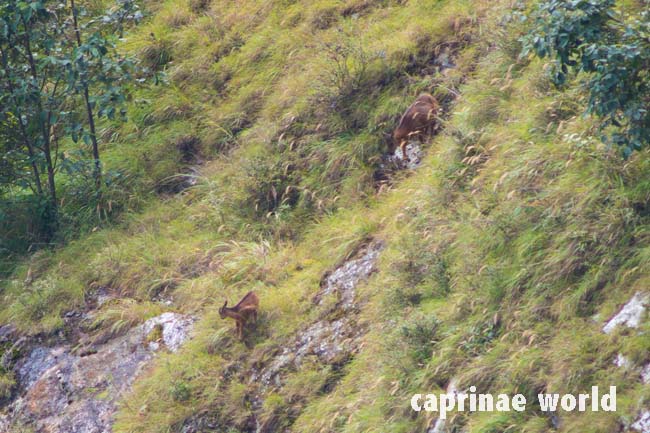
Red Goral habitat, Mishmi Hills, India. Photo: Ralf Bürglin
 Chinese Goral habitat, Qinling Mountains, China. Photo: Ralf Bürglin
Chinese Goral habitat, Qinling Mountains, China. Photo: Ralf Bürglin
Activity pattern
Gorals are crepuscular, most active in the morning and evening, but can be also active throughout the day. They typically live in small groups of 4 to 12 individuals, with older males being usually solitary. The diet consists of grasses, leaves, twigs and nuts. Goral are extremely agile and can move at high speeds across rough terrain. The lifespan is said to be up to 15 years. [1]
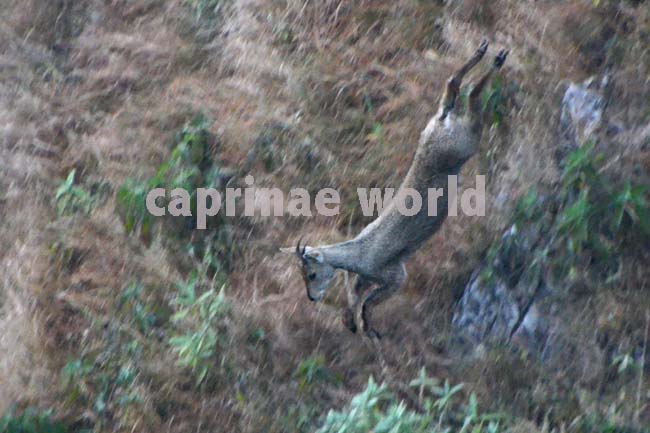
Goral are extremely agile and can move at high speeds across rough terrain. Photo: Himalayan Grey Goral, Majathal Sanctuary, Ralf Bürglin
Predators
Castelló (2016) mentions dhole, leopard, lynx, tiger, marten and wolf as predators for Himalayan gorals. [2] In Pakistan wolf and jackal are named to go after Himalayan Grey Gorals [6]. Major predators of Long-tailed Gorals are Grey Wolves and Eurasian Lynxes [4] and rarely Sibirian Tiger. [1]

The remains of a freshly killed Chinese Goral at Foping Nature Reserve, China. Note the rips chewed into pieces. Predator could not be identified. Photo: Ralf Bürglin
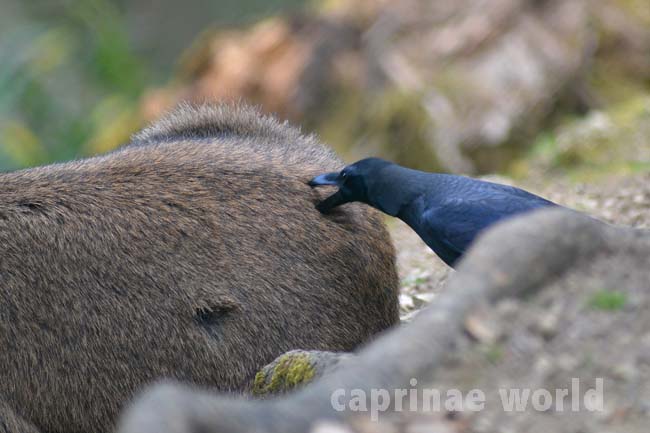
A Large-billed Crow (Corvus macrorhynchos) pinches a Himalayan Grey Goral at Kufri Zoo, India. The bird is presumably testing the goral for condition. The larger Common Raven is known to attack juvenile ungulates. Photo: Ralf Bürglin
Threats
Goral hunting by locals is widespread. They are killed for meat, fur, horns and medicine. In Thailand, goral have been hunted by locals for the oil that comes from boiling heads and bones. Habitat loss is a less serious problem, as the goral is largely confirmed to rugged, inaccessible areas. Competiton with livestock is a problem in some places. [1]
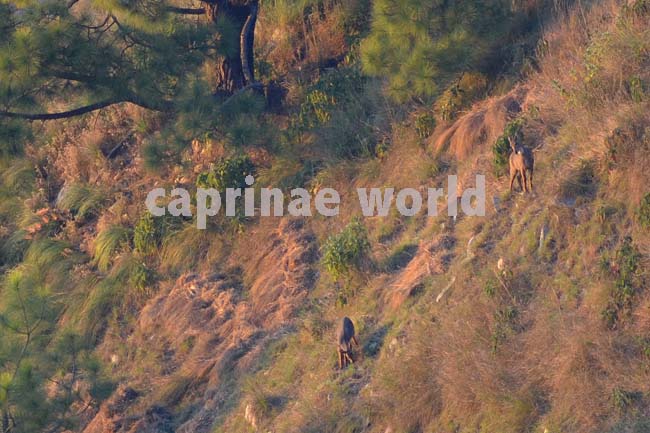
Two Himalayan Grey Gorals at Majathal Sanctuary, where local women have cut grass for fodder previously. Goral can occur in good numbers if suitable habitats are available and where grass and fodder cutting is moderate. [1] Photo: Ralf Bürglin
Trophy Hunting
In the past Nepal and China have offered goral hunting to foreign hunters, but not any more. For several years now, hunting has not been permitted in any of the range countries. [1]
Goral species
Six species of goral are presented here: I follow Hrbina (2015) in seperating Himalayan Grey Goral and Himalayan Brown Goral. Nemorhaedus cranbrooki is not taken into account due to lack of information.
Himalayan Brown Goral (Nemorhaedus hodgsoni) [7]
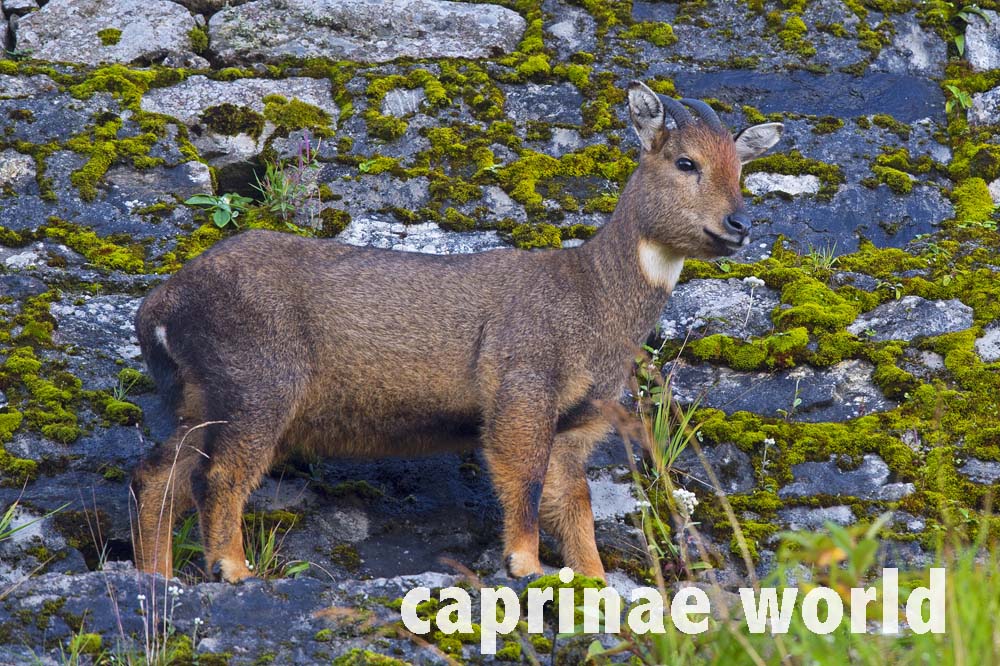
The Himalayan Brown Goral (Nemorhaedus hodgsoni) is brownish in colour and rather small in size. [3] It is native to Nepal, Bhutan and northeastern India. [1] Photo: Dhritiman Mukherjee, Zulik, East-Sikkim
Himalayan Grey Goral (Nemorhaedus goral) [7]

The Himalayan Grey Goral (Nemorhaedus goral) is often greyish and shows the small size of its eastern counterpart. [3] It can be found in Pakistan and Northwest India. [1] Photo: Ralf Bürglin
Chinese Goral (Nemorhaedus griseus)

The Chinese Goral (Nemorhaedus griseus) is among the bigger species and distributed through China and Northeast India. Photo: Ralf Bürglin
Burmese Goral (Nemorhaedus evansi)
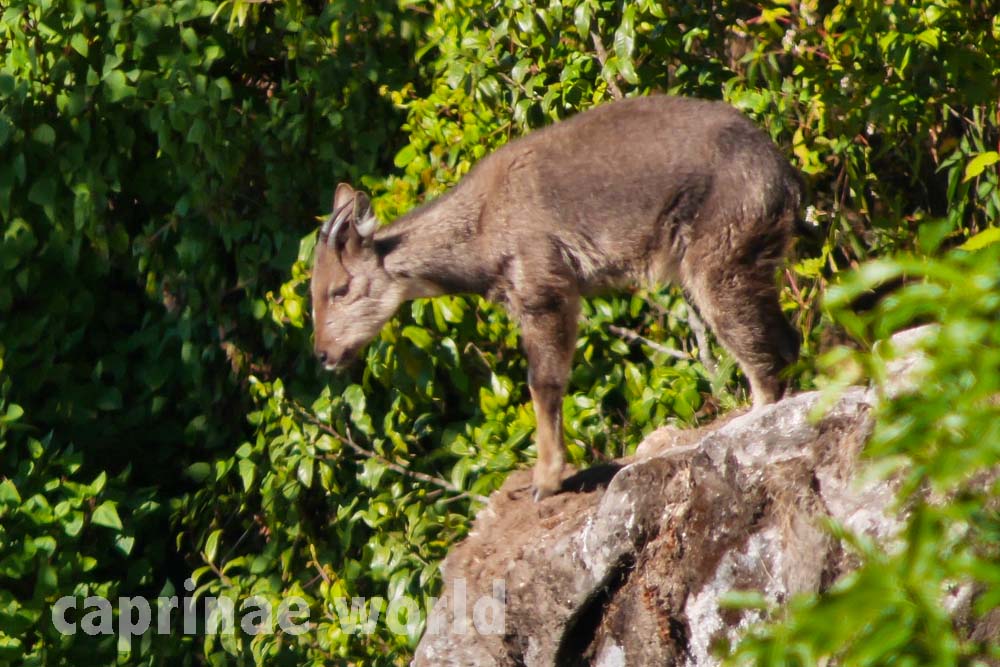
The Burmese Goral is a split from the Chinese Goral. It appears small in size and short-horned. Photo: Smith Sutibut, Thailand
Long-tailed Goral (Nemorhaedus caudatus)
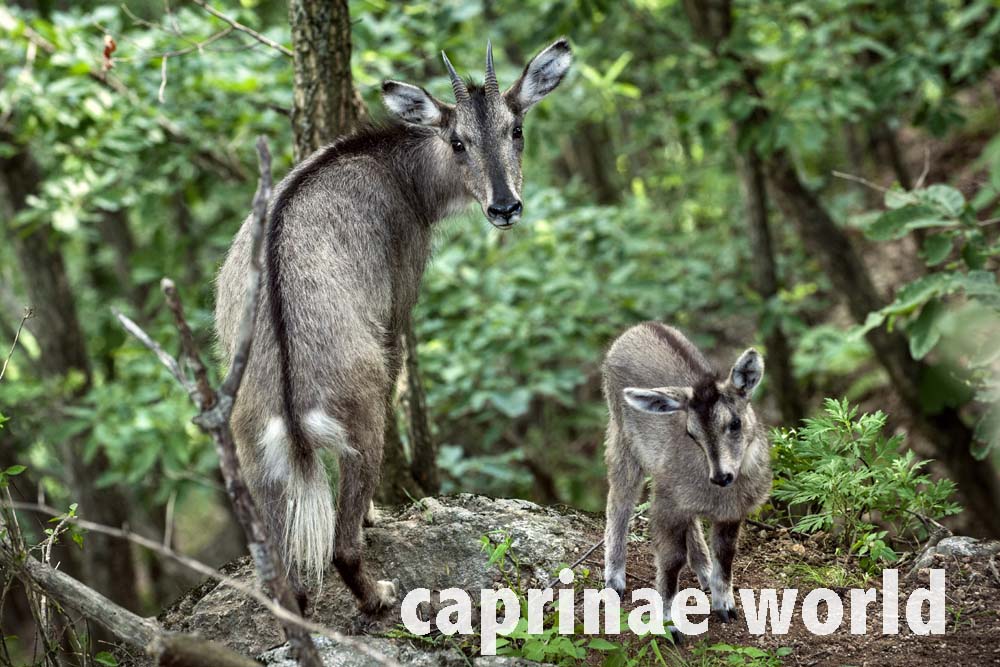
The Long-tailed Goral (Nemorhaedus caudatus) is among the bigger gorals. [4]. A striking features is the „tail with a very long brush“ [3]. In fact the white hairs that grow on the lateral surfaces of the tail constitute one of the most distinctive features for determining this species. [7] It can be found in the Far East: Russia, Northeast China, North Korea and South Korea [1]. Photo: Park Jongwoo, Hwacheon, South Korea. Adult female with young in summer coat, July 7, 2010.
Red Goral (Nemorhaedus baileyi)
The other possible „Red Goral“ (Nemorhaedus cranbrooki) is not (yet) taken into account here.
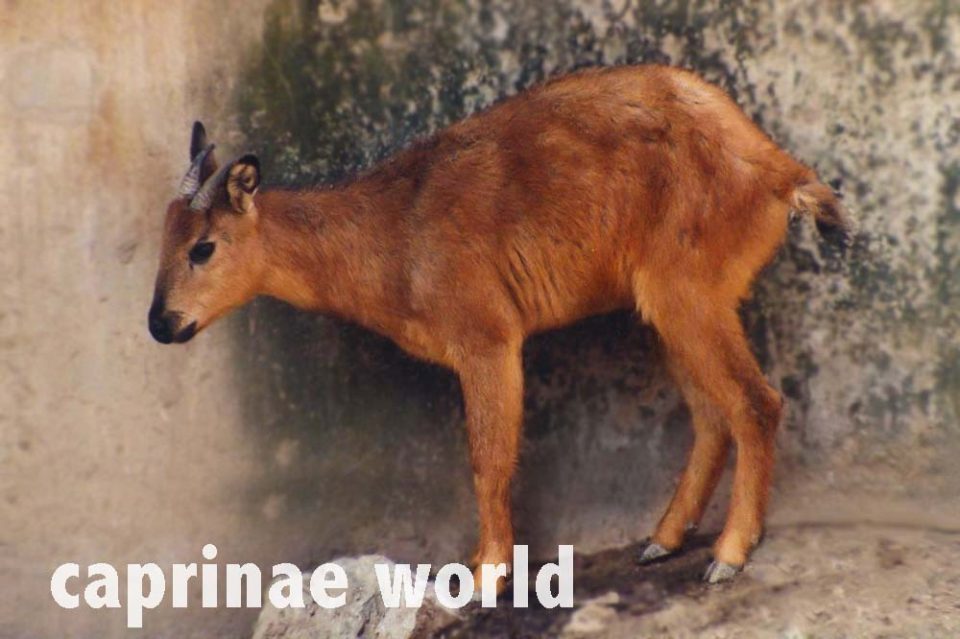
The Red Goral (Nemorhaedus baileyi) is about the small size of the Himalayan Gorals. [3]. It inhabits the extrem East of the Indian Himalayas and beyond that areas in Southwest China and Northern Myanmar. [1] Photo: Dr. Siegfried Czernay
Literature cited
[1] Damm, Gerhard R. and Franco, Nicolás, 2014: The CIC Caprinae Atlas of the World – CIC International Council for Game and Wildlife Conservation, Budakeszi, Hungary in cooperation with Rowland Ward Publications RSA (Pty) Ltd., Johannesburg, South Africa.
[2] Castelló, José R., 2016: Bovids of the world – Princeton Field Guides. Princeton University Press.
[3] Groves, Colin and Grubb, Peter, 2011: Ungulate taxonomy. The Johns Hopkins University Press.
[4] Wilson, D.E. and Mittermeier, R.A. [eds], 2011: Handbook of the Mammals of the World. Vol. 2. Hoofed Mammals. Lynx Edicions, Barcelona.
[5] The IUCN Red List of Threatened Species. Version 2016-3. <www.iucnredlist.org>. Downloaded on 10 January 2017.
[6] Perveen, Farzanaand and Khan, Anzela: „Migratory status of the goral, Nemorhaedus goral (Hardwicke) (Artiodactyla: Bovidae) in Kohistan, Pakistan.“ International Journal of Biodiversity and Conservation Vol. 5 (10) 2013, pp. 671-677
[7] Hrabina, Petr: „A new insight into the taxonomy and zoogeography of recent species of goral (Nemorhaedus, Bovidae, Ruminantia)“, Gazella 42, 2015, Zoo Praha
[8] Mori, Emiliano; Nerva, Luca; Lovari, Sandro, 2019: Reclassification of the serows and gorals: the end of a neverending story? Mammal Review ISSN 0305-1838.
[9] Bheem Dutt Joshi, Vinaya Kumar Singh, Hemant Singh, Saurav Bhattacharjee, Ashutosh Singh, Sujeet Kumar Singh, Kailash Chandra, Lalit Kumar Sharma und Mukesh Thakur: Revisiting taxonomic disparities in the genus Naemorhedus: new insights from Indian Himalayan Region. Mammalia 86 (4), 2022, S. 373–379, doi: 10.1515/mammalia-2021-0152
[10] Guogang Li, Nan Sun, Kyaw Swa, Mingxia Zhang, Ye Htet Lwin und Rui-Chang Quan: Phylogenetic reassessment of gorals with new evidence from northern Myanmar reveals five distinct species. Mammal Review 50, 2020, S. 325–330, doi: 10.1111/mam.12200
[11] Hrabina, Petr; Pernerová, Ludmila; Suchomel, Josef; Robovský, Jan, 2023: Utility of cytochrome c oxidase I for the deciphering of unstable phylogeny and taxonomy of gorals, genus Nemorhaedus, Hamilton Smith, 1827 (Bovidae, Ovibovina). https://zookeys.pensoft.net/article/108019/

